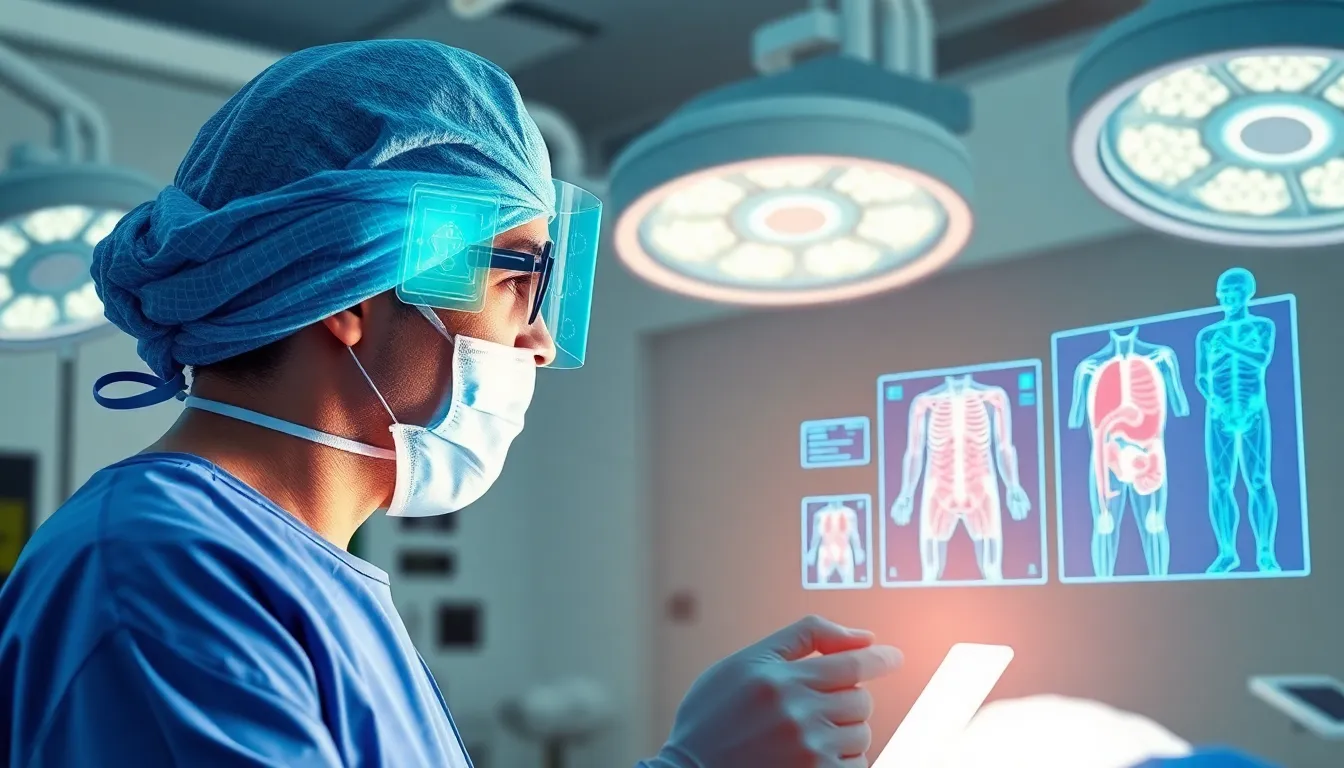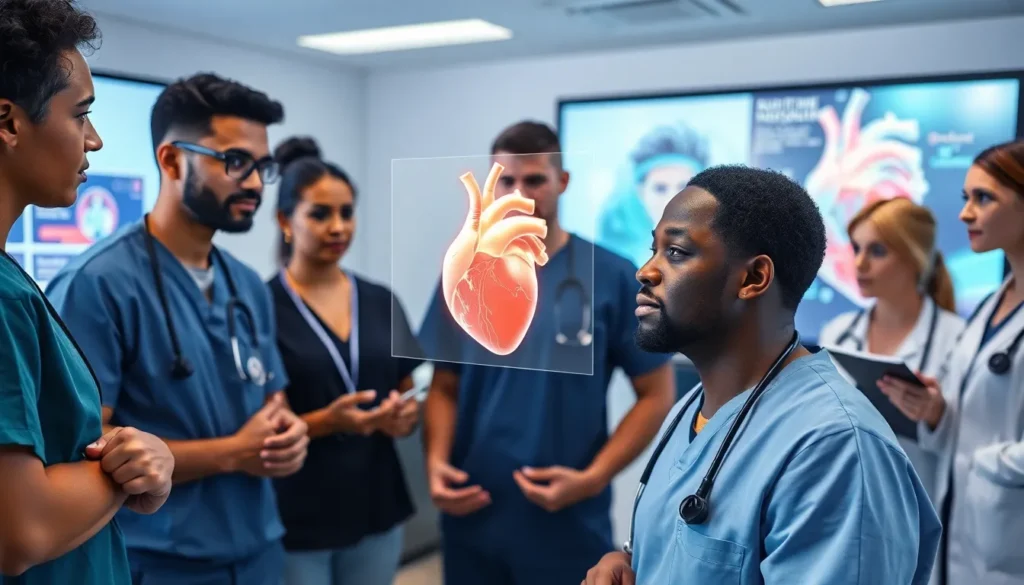Table of Contents
ToggleImagine walking into a doctor’s office where instead of staring at outdated charts, patients are greeted by 3D holograms of their own organs. Sounds like something out of a sci-fi movie, right? Well, welcome to the world of augmented reality in healthcare. This innovative technology is transforming the way medical professionals diagnose, treat, and educate, making healthcare not just smarter but also a bit more fun.
Augmented reality isn’t just about flashy gadgets; it’s about enhancing patient outcomes and making complex medical information as easy to digest as a slice of pizza. From training surgeons with lifelike simulations to helping patients visualize their treatment plans, AR is revolutionizing healthcare one pixel at a time. So buckle up and get ready to explore how this tech marvel is reshaping the future of medicine—because who said healthcare can’t be a little exciting?
Overview of Augmented Reality for Healthcare
Augmented reality (AR) integrates digital information with the real world, creating interactive experiences. In the healthcare sector, AR technology facilitates enhanced communication between medical professionals and patients. It utilizes 3D holograms for visualizing anatomy, making complex medical information easier to understand.
Improving diagnosis rates, AR applications offer precise imaging and visualization. Surgeons can practice procedures on virtual models before operating, reducing risks and increasing efficiency. This approach minimizes errors and boosts confidence during actual surgeries.
Engaging medical education benefits from AR, providing students with immersive training experiences. Virtual simulations enable learners to practice skills in real-time environments. Healthcare professionals can undertake continuous education through AR, keeping them abreast of advancements.
Patient engagement significantly improves through AR applications. Visual aids help in understanding treatment plans, fostering collaboration between patients and providers. Enhancements in patient satisfaction arise as individuals can visualize their health data in relatable formats.
Research indicates that AR can streamline workflows by improving the way information is accessed and shared. Mobile devices equipped with AR applications allow clinicians to retrieve data quickly during procedures. Such efficiency leads to better patient outcomes and optimizes resources within healthcare facilities.
Overall, AR’s impact on healthcare transforms various aspects of the field, from diagnosis and training to patient interactions and outcomes. This integration of technology aligns with the industry’s goal of delivering smarter, more effective healthcare solutions.
Benefits of Augmented Reality in Healthcare

Augmented reality (AR) offers significant advantages in healthcare, enhancing patient experiences and improving medical practices.
Enhanced Patient Education
AR technology improves patient education by providing interactive visual aids. Patients can grasp complex medical concepts through 3D visualizations of their conditions. Engaging with these holograms makes understanding treatment options easier and more effective. Tools like AR allow patients to visualize anatomy and procedures, fostering awareness of treatment plans. Research shows AR tools enhance comprehension rates, maximizing patient involvement in health decisions. These insights into personal health lead to more informed discussions between patients and healthcare providers.
Improved Surgical Precision
Surgeons benefit from AR by accessing critical information during procedures. This technology overlays vital data and imaging directly onto the surgical field. Enhanced visualization allows surgeons to see anatomical structures in real-time, increasing accuracy and safety. With AR, medical professionals can simulate operations beforehand, practicing on virtual models. Results indicate that this immersive training significantly lowers the risk of complications during real surgeries. Surgical teams utilize AR innovations to improve coordination, ultimately leading to better patient outcomes.
Applications of Augmented Reality in Medical Training
Augmented reality (AR) significantly enhances medical training by providing immersive educational experiences. This technology equips healthcare professionals with essential skills necessary for effective practice.
Simulation-Based Learning
Simulation-based learning using AR allows trainees to interact with 3D models of anatomical structures. These models provide opportunities to explore complex procedures in a risk-free environment. Medical students can visualize organs and systems, which aids in understanding their functions and relationships. Research shows that this hands-on approach improves retention rates among learners, making it easier to grasp challenging concepts. Moreover, AR simulations help assess competencies, ensuring that medical trainees possess the necessary skills before entering real-world settings. These immersive experiences transform traditional education methods, enhancing both engagement and the effectiveness of training programs.
Hands-On Training with AR
Hands-on training achieved through AR offers a unique platform for practical skill development. Learners engage with virtual patients, practicing procedures without the need for live subjects. This approach allows trainees to repeat tasks as many times as necessary, honing their skills in a safe setting. In surgical training, AR overlays critical information such as anatomical landmarks directly onto the view of the surgical field. Such features provide real-time feedback, which helps trainees make informed decisions during practice. Effectiveness is amplified as this technology prepares learners for actual surgical environments, minimizing potential errors. Overall, AR serves as a powerful tool, creating a more capable and confident healthcare workforce.
Future Trends in Augmented Reality for Healthcare
Augmented reality (AR) continues to evolve within the healthcare sector, paving the way for innovative applications and improvements in patient care. The integration of AR with emerging technologies, like artificial intelligence and machine learning, marks a significant trend. AI algorithms enhance AR experiences by providing personalized recommendations based on patient data. This synergy allows for smarter clinical decisions, as AR overlays critical health data onto real-time scenarios. With real-time data analysis, healthcare providers identify potential complications early, improving outcomes.
The expansion of AR into telemedicine demonstrates another promising trend. Virtual consultations now incorporate AR elements to visualize patient anatomy during remote sessions. This integration allows healthcare professionals to explain conditions more effectively while maintaining high engagement levels. As telehealth adoption grows, AR will enable practitioners to create immersive environments where patients feel more connected and understood. Through enhanced visualizations, medical teams can share detailed treatment plans, fostering collaborative care, even from a distance. This development enhances patient education and strengthens communication in healthcare settings.
Augmented reality is reshaping the landscape of healthcare by enhancing both patient and provider experiences. Its ability to visualize complex medical information and create realistic simulations is proving invaluable in diagnostics and training. As AR continues to evolve alongside technologies like AI and machine learning, its applications will only expand, leading to smarter clinical decisions and improved patient outcomes.
The integration of AR into telemedicine further exemplifies its potential to enhance communication and education in remote settings. With ongoing advancements, augmented reality is set to play a pivotal role in making healthcare more efficient, engaging, and accessible for everyone involved. The future of healthcare looks brighter with AR at the forefront of innovation.







